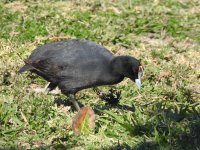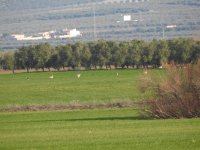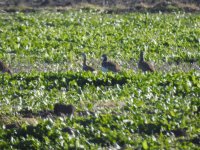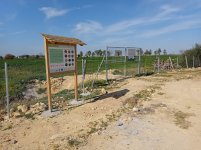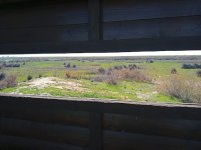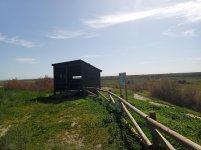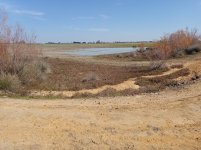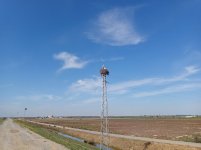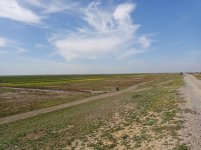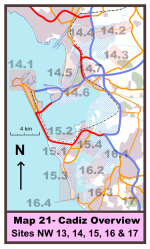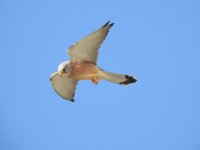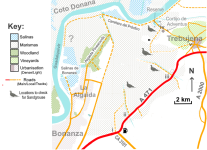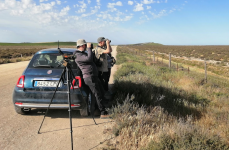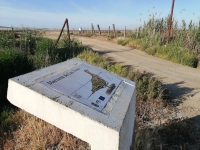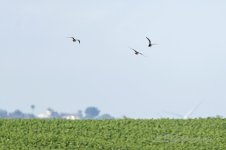Finding Pin-tailed Sandgrouse in Cadiz Province
For an embarrassingly long time,
Pin-tailed Sandgrouse was something of a 'bogey bird' for me in Cadiz Province although my chagrin at failing to find them was somewhat alleviated by the fact that other birders far more skilled than me also found them tricky. However, I think I’ve now cracked it as this year I’ve seen them six times in a row, mostly within 5-10 minutes of my arrival. So where to look for this iconic species? My map shows four areas worth checking (although I must confess I’ve found them regularly at only one of these locations).
View attachment 1510492
Two tracks converge on an area of reportedly particularly good sandgrouse habitat (
GPS 36.8226, -6.2671) a couple of km north of the
A 471. The first track (i) leaves the
A 471 at
GPS 36.7774 -6.2774 but I’ve found the latter part of the track along a channel is in poor condition. Entering via the second track (ii) at
GPS 36.7948, -6.26028 is both more direct and the track in better condition (although you still need to be careful negotiating the puddles and corrugations). I have explored this area a number of times (albeit not always at the optimum time of day) and it certainly looks very good but have never got lucky. However, other birders have been more fortunate, and the area is worth visiting for other good species including, depending on season and rainfall, large numbers of
egrets,
Glossy Ibis and
waders (inc. stints,
Ruff,
stilts,
Golden Plovers), a variety of raptors (inc.
Montagu’s Harrier,
Short-toed Eagle, etc),
short-toed and
Calandra Larks.
A third track along the
A 471 next to “
Trebujena Motorland” (iii -
GPS 36.8365, -6.2065) is also worth a closer inspection as it also offers good views across suitable habitat. When there’s standing water here then you can see hundreds of
egrets and
Glossy Ibis – wonderful sight. I’ve visited the area several times and had many good birds here … except, of course sandgrouse. In spring
2022 after an enforced absence for a number of years, tracking down this elusive bird was a priority. Hence I confess I was somewhat miffed when a keen Dutch birder to whom I gave details this site popped along the following morning and, on his first attempt, saw several sandgrouse (both in flight and on the ground). Naturally, when I looked there at dawn the following morning, I saw none at all, but my efforts were rewarded by finding a handsome
Great-spotted Cuckoo. My catalogue of failure, however, lasted less than an hour when I checked the Adventus track (iv –
GPS 36.8862, -6.2202). (Note the finca here is variously called the
Cortjo Alventus or
Cortijo de Adventus). Stopping 200m along the track to scan the marismas, I saw a small group in the distance and then had a couple of
Pin-tailed Sandgrouse fly over my head (see
May 2022 Update VII - Trebujena Area - going gaga or going gaaa-gaaa?). Somewhat to my surprise, I managed to repeat this feat at the same site the following autumn when I managed to show them to an old friend at the same location.
This spring keen to check whether my sudden success was a fluke, I visited the
Adventus track half-a-dozen times. To my great satisfaction, I saw
Pin-tailed Sandgrouse every time including several small flocks (up to 9 birds) and probably had a group of c20 birds too. The latter were rapidly scuttling across the horizon as I got out of the car so it’s hard to be 100% certain. Not only that but on three of those occasions birds flew over the track itself. What made the experience still sweeter was that on those three visits where the birds flew over nearby, I was able to show them to four friends for whom they were lifers and a fifth who had never seen them before in
Andalucía.
View attachment 1510489
My winning strategy has been to get to the
Adventus track as early as possible as that’s when when the birds are more active and the heat haze less of a problem. I then drive 200-300m along the track, stop and methodically scan the extensive marismas to the west. (Note that after rain this track can become dangerously slippery and driving along it is then inadvisable). In this way, I’ve repeatedly found groups of sandgrouse flying fast and low over the marismas with some pitching down towards the
Guadalquivir, others disappearing into cover near the small reserve and others continuing well into the distance. The birds, of course, know my strategy which is why the birds that came close to the track were all trying to sneak past behind me! A word of warning is needed though. Somewhat surprisingly, on all my recent visits there have been large numbers of
Grey Plovers (in various plumages) doing pretty much the same thing and, less surprisingly, I’ve seen
Golden Plover nearby in the past.
Plovers can superficially resemble
sandgrouse in flight but with a decent view there shouldn’t be a problem. However, they do constitute ornithological ‘white noise’ that can distract and make it easier for the target birds to slip through unnoticed! Even when the sandgrouse aren’t being obliging there’s still plenty to see –
Little Owl,
Glossy Ibis,
Calandra Larks,
raptors, etc.
It’s well worth exploring further along the track where, after c3 km, a handsome ceramic sign tells you that you’ve reached the Marisma de las Vetas. That it’s decorated with an illustration of
Pin-tailed Sandgrouse, is useful confirmation that you’re in the right place. Since by the time I reach this point it’s later in the day and I’ve probably already seen sandgrouse, I’ve not spent long looking here but the sign suggests it’s worth it. Besides, the ditches here conceal a good variety of herons (I’ve had all three
egrets,
Grey,
Purple,
Night and
Squacco here) and when flooded with shallow water (a rare circumstance in recent years) it attracts large numbers of
Glossy Ibis and waders. Here the track bends to the left to continue all the way to
Trebujena (c5 km). This route would certainly be worth exploring further as sandgrouse-friendly habitat continues until it reaches the low hill on which
Trebujena stands whereupon good
Rufous Bushchat habitat takes over. However, the condition of the track quickly deteriorates from this point on so it’s probably better to explore on foot. If arriving from
Trebujena this track starts at
GPS 36.8688, -6.1799 (v) next to the far end of
Parque La Toya. If you do explore this area, then feedback would be very useful as I’ve only done so a couple of times and even then fairly briefly (there are too many good sites here!).
View attachment 1510490
Assuming you don’t risk this route and you return the way you came along the
Adventus track when you reach the road down to the Guadalquivir turn left and park near the ruined tourist development (
Chozas Marismeñas). From here you have a good view across more dry halophytic vegetation. If the reserve here is open (it rarely seems to be) then a still better spot would be the small tower in its southern corner. Similarly scanning from the
Carretera del Práctico along the Guadalquivir near the reserve could pay dividends. Personally, I’ve never seen sandgrouse from either location largely because I've not tried too hard to do so, but others have and some of the birds I have seen from
Adventus track wappeared drop down into that area.
A final word. I remain somewhat puzzled why I managed to miss this species in this area for so long. I’m willing to accept that it might be sheer incompetence but, that said, I’ve regularly picked them up here before some of the excellent birders who’ve come with me to search for them and back in the day my hearing was up to detecting their calls at much greater range. The fact is that the birds seem to cover an enormous area as I've picked them up as dots on the western horizon, followed them as they rocketed past and then lost them again as they reverted to dots on the eastern horizon. Perhaps, the alarming desiccation of the
Coto Doñana has pushed more birds across the river or maybe, more optimistically, that process has increased the species’ population which is now overflowing across the Guadalquivir.
NB -For more photos & a longer, more discursive account of the trials and tribulations of finding sandgrouse see my blog on Cadiz Province (for details see footer).








